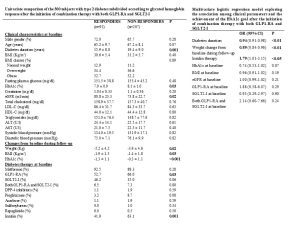Introduction: Glucagon-like peptide-1 receptor agonists (GLP1-RA) and sodium-glucose cotransporter-2 inhibitors (SGLT2-I) are innovative molecules for the treatment of type 2 diabetes (T2D) useful for both improving glucose control and reducing body weight and cardio-renal risk. Few studies evaluated the effect on glucose control of the contemporary use of GLP1-RA and SGLT2-I. Aim: To assess the effectiveness on glucose control of contemporary treatment with GLP1-RA and SGLT2-I in subjects with inadequately controlled T2D and to identify clinical predictors of glycated haemoglobin (HbA1c) reduction. Methods: Retrospective analysis of T2D subjects treated with the combination of both GLP1-RA and SGLT2-I. We selected 300 subjects with inadequate glucose control (HbA1c ≥7%) before the initiation of combination therapy (GLP1-RA or SGLT2-I), and we analysed the changes in HbA1c and other clinical parameters during the 6-12 months following the therapy. Subjects were classified as responder or non-responder according to HbA1c value (less than or more equal to 7%) during the follow-up. Univariate and multivariate analyses were performed to identify characteristics associated with response to combination therapy. Results: At baseline, the mean age was 66.5±8.7 years, diabetes duration was 18.3±8.8 years, 67% of the subjects were male, and more than half of them were obese (BMI 31.0± 5.6 kg/m2). The HbA1c target was achieved in 93 out of 300 subjects (31.0%) during the 6-12 months since combination therapy initiation. The univariate analysis showed that, at baseline, the responder vs non-responder group had a significantly lower diabetes duration (15.9±8.0 vs 19.4±9.0), HbA1c (7.9±0.9 vs 8.1±1.0), and prevalence of insulin use (41.9% vs 63.1%), and a higher estimated glomerular filtration rate (80.8±23.3 vs 73.8±22.7). The two groups were similar for the prevalence of chronic diabetes-related complications. During the follow-up, responders vs non-responders had a significantly higher reduction of weight, BMI, HbA1c, and a higher rate of insulin discontinuation (30.8% vs 8.5%, p<0.001). The multivariate analysis confirmed the predictive value of diabetes duration, insulin use, and weight reduction on the occurrence of HbA1c goal. Conclusions: Diabetes duration, insulin use, and weight reduction during therapy could predict the response to combination therapy with GLP1-RA and SGLT2-I.


